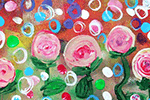The Children's Art Book
Papier-mâché Techniques
Papier-mâché is simply layers of paper or paste applied on the exterior of a structure, to give the sculpture a body of depth and volume. Almost anything can be a structure for papier-mâché. Plastic bottles, balloons, old cardboards, or even unused shoe boxes can be hardened to a durable and lightweight sculpture. With proper painting and glazing, your papier-mâché can be long lasting and up-cycled!
There are several ways to make papier-mâché. In this article, we will focus on the Paper Strips method, which involves using paper strips and paste, usually some form of liquid adhesive to get the paper strips sticky.
1. Preparing the Area
Papier-mâché will be very messy. Organise your area well to protect children, as well as your furniture. Dried papier-mâché on floor can be troublesome to remove, so be sure to plan your work area properly.
Work on a table. Papier-mâché can be time intensive (if the sculpture is large), so adopt a proper sitting posture during the work. Wrap an inexpensive plastic sheet over the table. Newspapers are not recommended, since liquid adhesives may seep through and damage your table underneath.
Work your papier-mâché on a large tray (such as a shallow food trays or taller foil trays). Trays can collect the papier-mâché drips, and are a stable platform when you need to move around to dry your sculpture.
2. Choosing Paper
Most water absorbent and porous papers will work. Newspapers are common, since they are readily available at home. Paper towels or thin brown shopping bags are flexible and easy to work with. Avoid shiny papers that can be thick and slippery. Finer papers, such as tissue, will allow a smoother surface and are suitable as finished layers, but can be fragile and prone to tearing. We prefer using newspapers for the first few layers of the sculpture as they are almost zero cost and out of sight, and plain white tissue paper as the finished layers as they make painting easier and provide a smoother finish.
Papier-mâché typically requires several layers of paper. A strong and long-lasting papier-mâché is important for sculptures, such as character face masks, which children interact and use often. The more layers, the stronger your sculpture will be. A simple work such as covering a photo frame may require a couple of layers of paper, while a more intricate 3D sculpture like a vase may require at least 4 layers or more to achieve the desired structure strength.
3. Preparing the Strips
Cut or tear papers into strips. Most of your sculpture will be covered by paper strips. You may prepare some odd shape patches to cover tight areas on your papier-mâché.
Cut paper strips are easy to prepare, with either a pen knife and a cutting mat, or a paper cutting tool. However, torn edges give a softer look, and mesh together nicely around the edges of the strip to create a smoother surface.
Since the edges are less defined, they also give finer finish to the sculpture. Children are naturally talented at tearing paper!
The length and width of the strips depends on the size of your sculpture. Keep them within 1 to 3 inches (both length and width) so that they are manageable for small fingers and can reduce drips. While wide strips can cover larger surfaces quickly, strips cut too wide will create corners, bumps and creases. Therefore, you may use several types of paper strips throughout your papier-mâché. Do whatever is quicker for the initial layers, and pay more attention to the finishing on the final layers.
4. Making the Paste
Liquid starch is a wonderful paste for young children, since they are ready to use out of the box.
Other pastes are also suitable for papier-mâché: Diluted white glue, or a mixture of flour and water. Both require some preparation with different costs.
- Diluted glue – Thin 1 part glue to 1 part water. Stir into consistent gluey texture in a bowl
- Flour & water: Mix 1 part flour to 1 part water. If you need smoother pastes for finished layers, use 2 part flour to 3 parts water. If you like, add a dash of cinnamon to freshen up the smell of your pastes.
We recommend liquid starch or thinned glue if you are located Singapore. Flour & water may turn mouldy if humid climates, even if it dries fully initially.
Latex gloves may help to prevent irritation from the adhesives, if children are not allergic to them. Avoid plastic food gloves, that tear easily and are slippery when wet.
5. Sculpture Frame
Your chosen frame should be solid, stable and strong enough to hold up its own weight, and the paper strips on it. Consider reinforcing with wire frames or use custom shape (such as cut up plastic bottles) bases to make arms, legs or extend the frame of the papier-mâché. Never leave any paper strip floating without a base!
There are many options that make ideal core, frames or supporting bases for your papier-mâché:
- Balloons, good ones that will not deflate for at least 2 days during drying. The children’s favourite
- Aluminium foil, that you can crush and mesh to form shapes
- Crumpled newspaper, secured to shape with masking tape
- Chicken wire (or grid wires for barbecues), for larger works such as landscapes
- Cardboard boxes, for custom made storage cases
- Plastic or cardboard bottles
Wash and clean your recycled materials, so you don’t have to remove them after the papier-mâché is dried. If you need to remove your frame, lay plastic sheets over the frame, so you can slide it out easily later!
6. Apply the Paper Strips
Pour it into a bowl, and drip your paper strips in the paste. Make sure that the entire surface of the paper is covered with paste. To prevent dripping, don’t over soak the paper. Have a damp sponge or towel to ready wipe excess starch off your work top or sculpture. Drips left on the sculpture can harden to tear drops if not removed.
Apply the paper strips in different directions (first layer horizontally, second layer vertically etc.) as you work through the frame. Besides giving your papier-mâché more strength and stability, the direction marks clearly where you have covered.
Smooth out wrinkles and creases from each paper strip with your fingers or a glue brush (a worn out paintbrush will do). Don’t keep any bumps, since they may show up more on the finished layers on top. Ideally, allow each layer to dry overnight for maximum strength. Most children don’t have the patience for that, so work up to 3-4 layers at once, but not more!
Papier-mâché is time consuming and physically demanding. Split up when working with children. Parents can drip the paper strips into the paste bowl, and children can apply the strips onto the frame. Swap duties occasionally to keep the work exciting.
7. Air dry completely
Leave your sculpture in a covered area with good air ventilation. This is especially important if you have used some form of glue as the paste. We hope you have been creating your papier-mâché on a tray so far!
Depending on the number of layers of papier-mâché, it may take a day or more to dry completely. While the surface may be dry to the touch, the layers underneath may still be wet and weak. Be patient and have sufficient drying time to prevent mould from building, especially in Singapore’s humid and wet weather.
Do not remove your frame (or burst the balloon) before the sculpture is fully dry. Doing so may cause the weight of the wet layers to crater downwards before the sculpture has achieved the desired strength. It will be tough keeping the children away from it, we promise!
8. Colouring & Detailing
Once your papier-mâché sculpture is fully dry and solid, it’s time to bring out the embellishments!
Form details with soft paper or thick strings, soaked in adhesive or paste. Twist, crunch or braid them to create lines and shapes. Foam or felt can also be used to bring texture and shape to 3D sculptures. For smaller details, use a pinch of paper mask to create emboss and edges. Allow any embellishments to dry completely (again!) before applying paint.
Acrylic paints are an ideal choice for children to paint their papier-mâché sculptures. They do not require dilution and are ready to use out of the tube. Avoid paints which requiring dilution, such as poster or water colours, as they may rehydrate the paper strips and cause mould to build up.
Seal your papier-mâché sculpture with several coatings of lacquer finish, either spray painted or brushed, to block out water and give it the polished look that it deserves.











